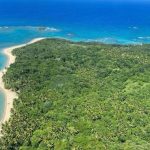Diablotín: Beata mountain range expedition logs 80 oceanic sightings

Santo Domingo.- The inaugural international scientific expedition aimed at designating the Beata mountain range as a protected oceanic region documented over 80 sightings of the black-headed petrel (Pterodroma hasitata), featuring two distinct morphotypes characteristic of the Dominican Republic and Haiti. Researchers infer that this locale serves as a crucial transit area for the diablotín, also known as the black-capped petrel.
Following discussions with the expedition’s researchers, including participants from the academic community and various media outlets, Minister of Environment and Natural Resources, Miguel Ceara Hatton, expressed optimism about the conservation prospects presented by the Cordillera Beata project.
During a virtual signing ceremony at the Palace alongside the Colombian Minister of Environment and President Luis Abinader, Ceara Hatton emphasized his satisfaction with reaching this milestone. He underscored the government’s commitment to the 30 by 30 initiative, aspiring to designate 30% of the nation’s land and sea as protected areas to align with global biodiversity frameworks aimed at natural resource preservation and climate change impact mitigation.
Acknowledging collaborative efforts, Ceara Hatton extended gratitude to key organizations such as the Caribbean Cetacean Society, Blue Marine Foundation, Mission Blue, Blue Nature Alliance, and the National Fund for the Environment (Marena Fund). He also thanked Anamar, Fundemar, the Grupo Puntacana Ecological Foundation, the Eco-Bahía Foundation, Cebse, and Colombian government delegates, all contributing to the success of the initiative in preserving marine biodiversity.
Vice Minister of Coastal and Marine Affairs, José Ramón López Reyes, participated in the meeting held at the Ministry of the Environment’s Multipurpose Room. The expedition, spanning 20 days and covering 2,740 kilometers, involved 12 Dominican researchers collaborating with counterparts from nine countries and islands, along with 14 organizations.
Jonathan Delance, the expedition coordinator, shared that the research included 355 hours of study, confirming the presence of three shark species, including the endangered oceanic whitetip shark. The discovery of the cigar shark suggests the potential for more intricate ecosystems at greater depths.
Delance noted that the preliminary findings include the identification of 18 bird species in 330 sightings, emphasizing the significance of the Beata mountain range as a feeding area for the diablotín. Sperm whale presence from clan number 2 of the Lesser Antilles indicates a connectivity link, and at least six cetacean species, including juveniles and adults, were observed, suggesting the area’s importance for reproduction and breeding.
While these results are preliminary, the comprehensive report, including data analysis, is expected in March, expanding the conservation significance of the Beata mountain range for the country, the Caribbean, and the global community.

















